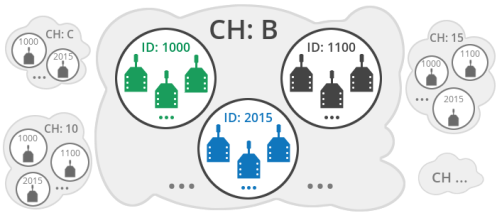Wireless communication
Compare XBee wireless communication to a telephone call. You pick up the phone and call one of your friends; here's the analogy as seen in the world of XBees:

- The caller (you) is the XBee that is sending data.
- The person receiving the call (your friend) is the destination module. The phone line is the wireless link established between the two XBees.
- And the "conversation" between you and your friend is the transmitted data.
The "phone line" in XBee wireless communication is established over the air. The modules transmit and receive information via modulation of waves in the electromagnetic spectrum. In order to transmit data from one XBee to other, both modules must be on the same frequency and in the same network. This is determined by the value of two parameters:
- Channel (CH) tells the XBee the frequency to use to communicate; that is, the channel inside their network. Like when you tune a radio to look for your favorite station, XBees in a network must use the same channel to "listen" to the rest.
- Personal Area Network identifier (ID) directs the XBees to talk to each other by establishing, via this unique identifier, that they are all part of the same network.

An XBee module will:
- Only receive data from other XBees within the same network (same ID value) and using the same channel (same CH value).
- Only be able to transmit data to other XBees within the same network (same ID value) and using the same channel (same CH value).
Note In this documentation, "modules in the same network" refer to the fact that they have the same value for their corresponding ID parameter (for example, 2015) and for their CH parameter (for example, B).
 PDF
PDF


